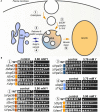Global Deletome Profile of Saccharomyces cerevisiae Exposed to the Technology-Critical Element Yttrium
- PMID: 30233513
- PMCID: PMC6131306
- DOI: 10.3389/fmicb.2018.02005
Global Deletome Profile of Saccharomyces cerevisiae Exposed to the Technology-Critical Element Yttrium
Abstract
The emergence of the technology-critical-element yttrium as a contaminant in the environment raises concern regarding its toxicological impact on living organisms. The molecular mechanisms underlying yttrium toxicity must be delineated. We considered the genomic phenotyping of a mutant collection of Saccharomyces cerevisiae to be of particular interest to decipher key cellular pathways involved either in yttrium toxicity or detoxification mechanisms. Among the 4733 mutants exposed to yttrium, 333 exhibited modified growth, of which 56 were sensitive and 277 were resistant. Several functions involved in yttrium toxicity mitigation emerged, primarily vacuolar acidification and retrograde transport. Conversely, functional categories overrepresented in the yttrium toxicity response included cytoskeleton organization and endocytosis, protein transport and vesicle trafficking, lipid metabolism, as well as signaling pathways. Comparison with similar studies carried out using other metals and stressors showed a response pattern similar to nickel stress. One third of the identified mutants highlighted peculiar cellular effects triggered by yttrium, specifically those affecting the pheromone-dependent signaling pathway or sphingolipid metabolic processes. Taken together, these data emphasize the role of the plasma membrane as a hotspot for yttrium toxicity. The up-to-now lack of data concerning yttrium toxicity at the cellular and molecular levels makes this pioneer study using the model S. cerevisiae an excellent first basis for the assessment of yttrium toxicity toward eukaryotes.
Keywords: Saccharomyces cerevisiae; genome-wide screening; technology critical element; yeast mutants; yttrium toxicity.
Figures






References
-
- Beeler T., Gable K., Zhao C., Dunn T. (1994). A novel protein, CSG2p, is required for Ca2+ regulation in Saccharomyces cerevisiae. J. Biol. Chem. 269 7279–7284. - PubMed
-
- Beeler T. J., Fu D., Rivera J., Monaghan E., Gable K., Dunn T. M. (1997). SUR1 (CSG1/BCL21), a gene necessary for growth of Saccharomyces cerevisiae in the presence of high Ca2+ concentrations at 37°C, is required for mannosylation of inositolphosphorylceramide. Mol. Gen Genet. 255 570–579. 10.1007/s004380050530 - DOI - PubMed
LinkOut - more resources
Full Text Sources
Other Literature Sources
Molecular Biology Databases

